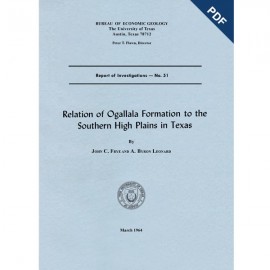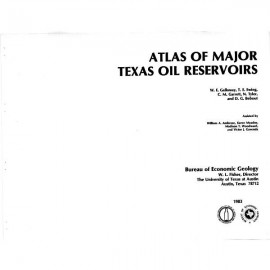Reports of Investigations
-
Books & Reports
- Reports of Investigations
- Guidebooks
- Udden Series
- Geological Circulars
- Down To Earth
- Atlases of Major Oil and Gas Reservoirs
- Texas Memorial Museum Publications
- Environmental Geologic Atlas of the Texas Coastal Zone
- Mineral Resource Circulars
- Other Reports
- Seminars and Workshops
- Handbooks
- Submerged Lands of Texas
- Symposia
- Annual Reports
- Open File Reports
-
Maps & Cross Sections
- Thematic Maps
- Miscellaneous Maps, Charts & Sections
- Geologic Atlas of Texas
- STATEMAP Project Maps
- Geologic Quadrangle Maps
- Cross Sections
- Highway Geology Map
- Energy and Mineral Resource Maps
- Shoreline Change and Other Posters
- Wilcox Group, East Texas, Geological / Hydrological Folios
- Bouguer Gravity Atlas of Texas
- River Basin Regional Studies
- Featured Maps
- Posters
- Teachers & the Public
-
Geological Society Publications
- Gulf Coast Association of Geological Societies
- Alabama Geological Society
- Austin Geological Society
- Corpus Christi Geological Society
- Houston Geological Society
- Lafayette Geological Society
- Mississippi Geological Society
- New Orleans Geological Society
- South Texas Geological Society
- GCS SEPM Publications
- Historic BEG & UT Series
Shallow-Seismic Evidence for Playa Basin Development ...on the Southern High Plains, Texas. Digital Download
RI0233D
For a print version: RI0233.
RI0233D. Shallow-Seismic Evidence for Playa Basin Development by Dissolution-Induced Subsidence on the Southern High Plains, Texas, by J. G. Paine. 47 p., 37 figs., 6 tables, 1995. doi.org/10.23867/RI0233D. Downloadable PDF.
To purchase this publication in book format, please order RI0233.
ABSTRACT
The origin of thousands of playa basins on the Southern High Plains of Texas and New Mexico has been attributed to eolian deflation, evaporite or carbonate dissolution and subsidence, piping, or animal activity. Shallow-seismic data from three ephemeral lake (playa) basins in the Texas Panhandle, collected as part of a hydrogeological study of High Plains playa and interplaya environments, demonstrate that subsidence has figured prominently in the formation of these three basins. Sevenmile Basin, Pantex Playa 3, and Pantex Lake, playas that occupy basins varying from 1.2 to 5.5 km in diameter, have 4 to 9 m of surface relief and contain lacustrine and eolian sediments that interfinger with the Quaternary Blackwater Draw Formation. Below these sediments lies the upper Tertiary Ogallala Formation, which overlies Permian or Triassic bedrock. We collected seismic reflection and refraction data across these basins to investigate their geological history and hydrogeological framework and to help explain the mechanism by which they recharge the regionally important Ogallala aquifer.
Sevenmile Basin, 25 km east of Amarillo, Texas, is the largest of the three playa basins studied. The reflection section shows a middle Ogallala reflector, another reflector produced by an erosional unconformity at the top of Permian or Triassic bedrock, and reflectors within bedrock that indicate a structural low beneath Sevenmile Basin. Relief increases with depth, ranging from 9 m at the surface to 70 m on the middle Ogallala reflector to 110 m at the unconformity at the base of the Ogallala. Reflection data at Pantex Playa 3, a small playa about 25 km northeast of Amarillo, reveal the presence of four major reflecting horizons. Each horizon mimics surface topography, and relief increases with depth: the playa floor lies 4 m below the upland; the Ogallala caprock, absent directly under the playa, has 16 m of relief; an upper Ogallala fine-grained zone has 30 m of relief; a stratigraphic boundary between lower Ogallala coarse fluvial deposits and finer middle Ogallala lacustrine and fluvial deposits has 35 m of relief; and the erosional Permian or Triassic bedrock surface has 75 m of relief.
At Pantex Lake, which is situated in a large, irregularly shaped basin 34 km northeast of Amarillo, five strong reflecting horizons can be correlated to recurring geophysical log patterns in nearby water wells. The shallowest reflector, not visible directly beneath Pantex Lake, is thought to be from the Ogallala caprock. Deeper reflectors are interpreted to be (1) the top of a conductive, fine-grained (dominantly clay to sandy clay) section in the middle of the Ogallala Formation; (2) the boundary between a lower Ogallala resistive and coarse-grained (clayey sand to gravelly sand) zone and the conductive, fine-grained zone composing the middle Ogallala section; (3) a stratigraphic boundary within the lower Ogallala coarse-grained zone; and (4) the top of eroded Permian or Triassic bedrock. Relief on each surface increases with depth: the playa floor lies 6 m below the upland, the top of the middle Ogallala fine-grained zone has 28 m of relief, the boundary between lower Ogallala resistive and middle Ogallala conductive zones has 31 m of relief, and the lower Ogallala and Permian or Triassic bedrock reflectors have 45 to 50 m of relief.
Relief increasing with age indicates that subsidence, probably caused by dissolution of underlying Permian evaporites, has played a role in the formation of each basin. A combined Ogallala Formation and Blackwater Draw Formation thickness greater than bedrock relief suggests that subsidence began before or during Ogallala deposition and may continue to this day. Pedogenic carbonate is less abundant directly beneath the playas than it is beneath uplands adjacent to the playas. Either pedogenic carbonate formed beneath these playas and was subsequently removed by erosion or dissolution, or it never formed beneath perennially wet basins that have probably existed since Ogallala deposition.
Keywords: High Plains, playa basins, salt dissolution, seismic reflection, subsidence
CONTENTS
Abstract
Introduction
Methods
Well Log Analysis
Seismic Methods
Seismic Refraction
Seismic Reflection
Acquisition Geometry Seismic Tests
Processing
Results and Interpretations
Sevenmile Basin
Refraction Spreads PRR1, PRR2, and PRR3
Reflection Line PRL7
Pantex Playa 3
Refraction Spreads PRRA and PRRB
Reflection Line PRLA 3
Reflection Line PRLB 7
Pantex Lake
Subsurface Control
Well 6-44-3A
Well 6-44-3B
Well 6-44-3C
Section B-B'
Refraction Spreads PRRC and PRRD
Reflection Line PRLC
Discussion
Subsidence at Playa Basins
Dissolution of Permian Evaporites
Pedogenic Carbonate Accumulation
Conclusions
Acknowledgments
References
Figures
1. Location of study area in the Texas Panhandle
2. Location of playa and interplaya seismic lines near Pantex Plant
3. Regional structural elements of Texas Panhandle and eastern New Mexico
4. North-south stratigraphic cross section A-A' of Amarillo Uplift and northern part of Palo Duro Basin
5. Aerial photograph of Sevenmile Basin
6. Map of Sevenmile Basin showing refraction spreads PRR1, PRR2, and PRR3 and reflection line PRL7
7. Width and depth ranges of playa basins on the Southern High Plains
8. Map of Pantex Playa 3 showing seismic reflection lines PRLA and PRLB and refraction spreads PRRA and PRRB
9. Map of Pantex Lake showing seismic reflection line PRLC, refraction spreads PRRC and PRRD, and line of well log section B-B'
10. Bison EWG-I11 accelerated weight-drop seismic source
11. Unprocessed field record PRLB0092 from seismic reflection survey of Playa 3 and interpreted types of recorded seismic energy
12. First arrival times, layer assignments, and best-fit layer velocities of Sevenmile Basin refraction spreads
13. Comparison of driller's log from water well 6-44-9D with three profiles constructed from reversed refraction data across Sevenmile Basin
14. Surface elevation, uninterpreted seismic section, and interpreted seismic section along reflection line PRL7 across Sevenmile Basin
15. Seismic velocity profiles derived from reversed refraction spreads PRR1, PRR2, and PRR3 at Sevenmile Basin
16. Stacking velocity picks and best-fit velocity functions of seismic reflection lines at Sevenmile Basin, Playa 3, and Pantex Lake
17. Sediment thickness along reflection line PRL7 at Sevenmile Basin
18. Elevations of horizons 1 and 2 along reflection line PRL7 at Sevenmile Basin
19. Center-shot field records PRRA0003 and PRRB0003 from refraction survey of Playa 3
20. First arrival time picks, layer assignments, and best-fit apparent velocities of playa-floor refraction spread PRRA and upland spread PRRB at Playa 3
21. Surface elevation, uninterpreted seismic section, and interpreted seismic section along reflection line PRLA across Playa 3
22. Textural log of Ogallala monitoring well WR-47
23. Thicknesses of deposits calculated between horizons 0, 1.2, and 3 and the surface along Playa 3 reflection line PRLA
24. North-south cross section of Playa 3 reflection line PRLA
25. Surface elevation, uninterpreted seismic section, and interpreted seismic section along reflection line PRLB across Playa 3
26. Thicknesses of deposits calculated between horizons 0, 1,2, and 3 and the surface along Playa 3 reflection line PRLB
27. Northwest-southeast cross section of Playa 3 reflection line PRLB
28. Textural, spontaneous potential, resistivity, and induction logs of well 6-44-3A
29. Textural and resistivity logs of well 6-44-3B
30. Textural, spontaneous potential, resistivity, and induction logs of well 6-44-3C
31. West-east cross section B-B' constructed from resistivity logs of wells 6-44-3A, 6-44-3B, and 6-44-3C
32. First arrival time picks, layer assignments, and best-fit apparent velocities of Pantex Lake refraction spreads PRRC and PRRD
33. Surface elevation, uninterpreted seismic section, and interpreted seismic section along reflection line PRLC across Pantex Lake
34. Thicknesses of deposits calculated between horizons 0, 1, 2 ,3, and 4 and the surface along Pantex Lake reflection line PRLC
35. West-east cross section of Pantex Lake reflection line PRLC
36. Relationship between maximum relief on major reflecting horizons and depths to horizons at Sevenmile Basin, Playa 3, and Pantex Lake
37. Velocity picks and time picks of horizon 2 from CMP gathers along Pantex Lake reflection line PRLC
Tables
1. Line lengths of shallow seismic reflection data collected near the Pantex Plant
2. Playa and enclosing basin dimensions of Sevenmile Basin, Playa 3, and Pantex Lake
3. Acquisition geometry and recording parameters of seismic refraction surveys
4. Acquisition geometry and recording parameters of seismic reflection surveys
5. Processing steps, parameters, and purpose of each step used in converting seismic reflection data to final sections
6. Summary of reversed refraction data from Sevenmile Basin, Playa 3, and Pantex Lake
Citation
Paine, J. G., 1995, Shallow-Seismic Evidence for Playa Basin Development by Dissolution-Induced Subsidence on the Southern High Plains, Texas: The University of Texas at Austin, Bureau of Economic Geology, Report of Investigations No. 233, 47 p. doi.org/10.23867/RI0233D.






